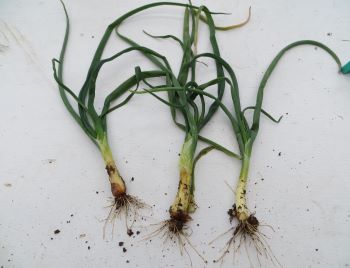Allium Leaf Miner Project
Lead scientist: Gaylord Desurmont
Presentation & context
The allium leafminer Phytomyza gymnostoma (Diptera: Agromyzidae) is an emerging invasive pest in Eastern U.S. It was first detected in 2015 in Pennsylvania and has been since then recorded in New York state, Maryland, and New Jersey (Barringer et al. 2018). The allium leaf miner attacks a wide range of species belonging to the Allium genus including cultivated crops such as onion, garlic, leek, scallions, shallots, and chives. Larvae of P. gymnostoma mine the leaves of susceptible plants, then pupate by the basis of the leaves. Under temperate climate, P. gymnostoma has two generations per year: a spring generation that goes through summer diapause, then a fall generation that overwinters as pupa (Durlin et al. 2017). Larval damage can cause leaves of young plants to twist and curl, impeding their growth, and can render full grown crops unmarketable (Durlin et al. 2017, Barringer et al. 2018).
Leaf wilting caused by the allium leaf miner to young leek plants (photo credit: the green thumb 2.0)
A: Allium leaf miner female ovipositing
B: Couple of allium leaf miner adults mating
Moreover, P. gymnostoma larval damage is often an entry door for pathogen infection such as bacterial rot. High densities of allium leaf miner have been recorded in Eastern U.S. with as many as 20 pupae per plant and 100% of plants infested in cultivated fields (Barringer et al. 2018). This species is on its way to pose a major threat for Allium crop production throughout the northeast and potentially to all North America. Moreover, the genus Allium contains 150+ species in the U.S., including many wild and weedy species. The emergence of this invader may threaten some of the native Allium species while these plants may also serve as potential breeding reservoirs for the pest. Of particular interest is the three-cornered leek Allium triquetrum. This plant is native to Europe, considered invasive in Australia and established in North America where it can be locally abundant (Bossard et al. 2000, Tehranchian et al. 2014). Its presence could potentially facilitate the spread of the fly in its invasive range.
Research components
Classical biological control shows strong potential to limit the economic impact of the allium leaf miner. Indeed several parasitoids have been documented attacking P. gymnostoma in its native range and can be abundant: for example, in a survey of natural enemies conducted in Serbia, the rate of parasitism of P. gymnostoma by the single parasitoid Halticoptera circulus (Hymenoptera: Pteromalidae) was found to be 23%(Spasić and Mihajlović 1997). Interestingly, although P. gymnostoma has been originally described in Poland in 1858, it has only started to be considered as a destructive pest in European countries toward the end of the 20th century, following a progression from east to west in Europe (Hungary: 1986; Croatia: 1990; Serbia: 1992; Germany: 1994; Switzerland: 2003; France: 2003; United Kingdom: 2003). In most European countries where it became a pest, P. gymnostoma’s damage peaked rapidly in the years following the initial reports, then gradually decreased to reach a situation of quasi-stability, and the part played by native natural enemies in this process is likely to be significant (L. Durlin, personal communication). The native range of this species encompasses most of Europe, where it has been documented from Spain to Denmark and from the United Kingdom to Ukraine, and it is also present in Asia with records in Turkey and Turkmenistan. Several research questions needs to be answered in order to develop a successful biological control program of this emerging pest:
1) what is the geographical origin of the allium leaf miner population(s) that invaded the U.S.?
2) what is the assemblage of natural enemies that attack the allium leaf miner is its native range?
3) what is the efficacy and host specificity of these natural enemies?
Miscogaster sp., a parasitoid of the allium leaf miner found in Europe (photo credit: Mike Gates)
References
Barringer, L. E., S. J. Fleischer, D. Roberts, S.-E. Spichiger, and T. Elkner. 2018. The First North American Record of the Allium Leafminer. Journal of Integrated Pest Management 9: 8.
Bossard, C. C., J. M. Randall, and M. C. Hoshovsky. 2000. Invasive plants of California's wildlands, Univ of California Press.
Durlin, L., S. Picault, S. Pollet, and S. Oste 2017. Biological study of the emerging pest Phytomyza gymnostoma: necessity for the integrated pest management (IPM)[Conference poster], pp. 53-62. In, 6e COMAPPI, Conférence sur les Moyens Alternatifs de Protection pour une Production Intégrée, Lille, France, 21-23 mars 2017, 2017. Association Française de Protection des Plantes (AFPP).
Spasić, R., and L. Mihajlović 1997. Napomyza gymnostoma Loew-a pest on bulbed vegetables in Serbia and its parasitoids, pp. 549-552. In, Quatrième Conférence Internationale sur les Ravageurs en Agriculture, 6-7-8 janvier 1997, le Corum, Montpellier, France. Tome 2., 1997. Association Nationale pour la Protection des Plantes (ANPP).
Tehranchian, P., R. Adair, and A. Lawrie. 2014. Potential for biological control of the weed angled onion (Allium triquetrum) by the fungus Stromatinia cepivora in Australia. Australasian Plant Pathology 43: 381-392.




